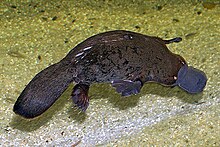Ornithorhynchidae
| Ornithorhynchidae | |
|---|---|

| |
| Platypus | |
| Scientific classification | |
| Domain: | Eukaryota |
| Kingdom: | Animalia |
| Phylum: | Chordata |
| Class: | Mammalia |
| Order: | Monotremata |
| Superfamily: | Ornithorhynchoidea |
| Family: | Ornithorhynchidae J. E. Gray, 1825 |
| Genera | |
The Ornithorhynchidae /ɔːrˌnɪθəˈrɪŋkɪdiː/ are one of the two extant families in the order Monotremata, and contain the platypus and its extinct relatives. The other family is the Tachyglossidae, or echidnas.
Within the Ornithorhynchidae are the main Cenozoic genera Ornithorhynchus and Obdurodon, and several potential stem-genera dating back to the Late Cretaceous, of which the oldest is possibly Dharragarra. Although fossil evidence suggests the presence of ornithorhynchids in the Cretaceous, phylogenetic evidence has largely found that they and the Tachyglossidae only diverged during the Cenozoic, although this varies based on the specific constraints used.[1]
The following species are known:[1]
- Family Ornithorhynchidae
- Genus Ornithorhynchus (Pliocene to present)
- Ornithorhynchus anatinus (the modern platypus)
- Genus †Obdurodon (Oligocene to Miocene)
- Genus ?†Dharragarra (Late Cretaceous; Cenomanian)
- Genus ?†Monotrematum (Early Paleocene)
- Genus ?†Patagorhynchus (Late Cretaceous; Maastrichtian)
- Genus Ornithorhynchus (Pliocene to present)
Although extant ornithorhynchids and most fossil genera are known from Australia, at least two potential genera (Monotrematum and Patagorhynchus) inhabited the southern tip of South America during the Maastrichtian and Paleocene, having presumably migrated there across Antarctica from Australia.[1]
Another two genera, Steropodon and Teinolophos, were originally thought to belong to the Ornithorhynchidae. However, they were both placed into a new family, the Steropodontidae.[2] This decision was made based on differences in the dentary recovered from the Griman Creek Formation, Lightning Ridge, New South Wales, Australia. This dentary is the holotype for the genus Steropodon, thus the lack of information led to the original misclassification. Further research on Teinolophos has indeed shown it to be an animal much different from ornithochrynchids, lacking a beak, possessing a more complete mammalian dentition, and retaining primitive ears connected to the jaw as in more basal mammals.[3] In 2022 it was proposed to move Steropodon into its own family, Teinolophidae.[4]
The extinct Ornithorhynchus maximus has been included in Ornithorhynchus, but later placed with the echidna family Tachyglossidae as Zaglossus robustus.[5]
References[edit]
- ^ a b c Flannery, Timothy F.; McCurry, Matthew R.; Rich, Thomas H.; Vickers-Rich, Patricia; Smith, Elizabeth T.; Helgen, Kristofer M. (2024-05-26). "A diverse assemblage of monotremes (Monotremata) from the Cenomanian Lightning Ridge fauna of New South Wales, Australia". Alcheringa: An Australasian Journal of Palaeontology: 1–19. doi:10.1080/03115518.2024.2348753. ISSN 0311-5518.
- ^ Flannery, Timothy F.; Archer, Michael; Rich, Thomas H.; Jones, Robert (5 October 1995). "A new family of monotremes from the Creataceous of Australia". Nature. 377 (6548): 418–420. Bibcode:1995Natur.377..418F. doi:10.1038/377418a0. S2CID 4301982.
- ^ Thomas H. Rich, James A. Hopson, Pamela G. Gill, Peter Trusler, Sally Rogers-Davidson, Steve Morton, Richard L. Cifelli, David Pickering, Lesley Kool, Karen Siu, Flame A. Burgmann, Tim Senden, Alistair R. Evans, Barbara E. Wagstaff, Doris Seegets-Villiers, Ian J. Corfe, Timothy F. Flannery, Ken Walker, Anne M. Musser, Michael Archer, Rebecca Pian and Patricia Vickers-Rich (2016). "The mandible and dentition of the Early Cretaceous monotreme Teinolophos trusleri". Alcheringa: An Australasian Journal of Palaeontology. in press. doi:10.1080/03115518.2016.1180034.
- ^ Flannery, T. F.; Rich, T. H.; Vickers-Rich, P.; Ziegler, T.; Veatch, E. G.; Helgen, K. M. (2022). "A review of monotreme (Monotremata) evolution". Alcheringa: An Australasian Journal of Palaeontology. 46: 3–20. doi:10.1080/03115518.2022.2025900. S2CID 247542433.
- ^ Musser, A. M. (2003). "Review of the monotreme fossil record and comparison of palaeontological and molecular data". Comparative Biochemistry and Physiology A. 136 (4): 927–42. doi:10.1016/s1095-6433(03)00275-7. PMID 14667856.
- Groves, C. P. (2005). Wilson, D. E.; Reeder, D. M. (eds.). Mammal Species of the World: A Taxonomic and Geographic Reference (3rd ed.). Baltimore: Johns Hopkins University Press. p. 2. ISBN 0-801-88221-4. OCLC 62265494.






